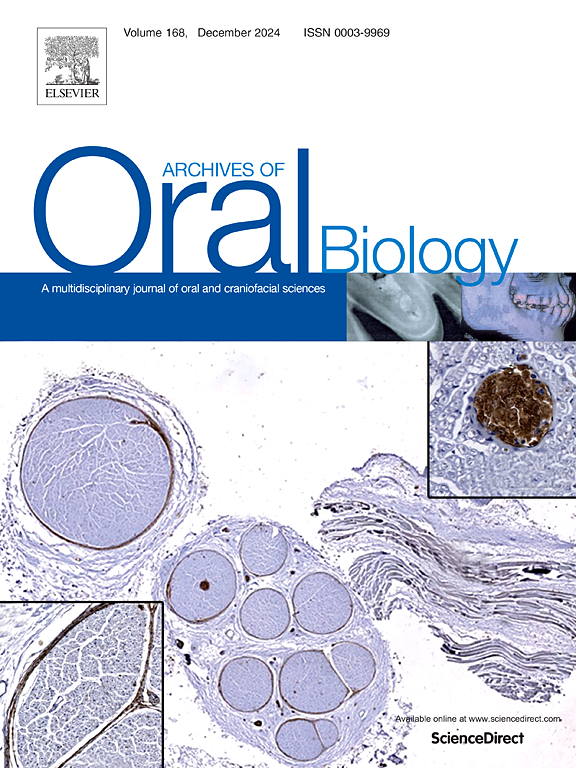Allyl isothiocyanate suppressed periodontal tissue destruction in mice via bacteriostatic and anti-inflammatory activities against Porphyromonas gingivalis
IF 2.2
4区 医学
Q2 DENTISTRY, ORAL SURGERY & MEDICINE
引用次数: 0
Abstract
Objectives
Allyl isothiocyanate (AITC) is a phytochemical that is abundantly present in cruciferous vegetables, such as wasabi and mustard. Among its pharmacological properties, it demonstrates anticancer, antifungal, and anti-inflammatory activities. This study aimed to investigate the functions of AITC against periodontopathic bacteria and its effects on a mouse model of periodontitis.
Design
The antimicrobial and antibiofilm functions of AITC were assessed against Porphyromonas gingivalis, Fusobacterium nucleatum, and Streptococcus mitis. To clarify its anti-inflammatory effects, macrophage-like cells from THP-1 were stimulated with P. gingivalis lipopolysaccharide (LPS), and the release of inflammatory cytokines was analyzed by ELISA. Experimental periodontitis was induced in 9-week-old mice by ligation and oral infection of P. gingivalis, and AITC was injected into the gingiva once daily for 8 days. Alveolar bone resorption was evaluated by measuring the exposed root area. Gene expressions in the periodontal tissue were analyzed via qPCR.
Results
AITC exerted weak bacteriostatic effects against P. gingivalis, inhibiting biofilm formation. AITC also impeded the production of interleukin-6 and tumor necrosis factor-α induced by P. gingivalis LPS. Additionally, transient receptor potential ankyrin 1(TRPA1) channel agonist inhibited the anti-inflammatory effects of AITC. In vivo, AITC inhibited alveolar bone destruction and decreased the gene transcription of Il6 in the periodontal tissue.
Conclusion
AITC exerted weak bacteriostatic and anti-inflammatory effects against P. gingivalis, reducing alveolar bone destruction and suppressing the inflammatory response in experimental periodontitis. Therefore, AITC may serve as a valuable adjunct in controlling periodontal disease.
异硫氰酸烯丙酯通过对牙龈卟啉单胞菌的抑菌和消炎作用抑制小鼠牙周组织的破坏
目的异硫氰酸烯丙酯(AITC)是一种植物化学物质,大量存在于芥末和芥菜等十字花科蔬菜中。在其药理特性中,它具有抗癌、抗真菌和抗炎活性。本研究旨在探讨 AITC 对抗牙周病细菌的功能及其对牙周炎小鼠模型的影响。设计评估了 AITC 对抗牙龈卟啉单胞菌、核酸化脓杆菌和米炎链球菌的抗菌和抗生物膜功能。为明确其抗炎作用,用牙龈卟啉菌脂多糖(LPS)刺激 THP-1 巨噬细胞样细胞,并用 ELISA 分析炎症细胞因子的释放。通过结扎和口腔感染牙龈脓毒性噬菌体诱导 9 周大的小鼠患上实验性牙周炎,然后向牙龈注射 AITC,每天一次,连续注射 8 天。通过测量暴露的牙根面积来评估牙槽骨吸收情况。结果 AITC 对牙龈脓毒性龈脓杆菌有微弱的抑菌作用,可抑制生物膜的形成。AITC 还能抑制牙龈脓疱梭菌 LPS 诱导的白细胞介素-6 和肿瘤坏死因子-α 的产生。此外,瞬时受体电位ankyrin 1(TRPA1)通道激动剂抑制了 AITC 的抗炎作用。结论 AITC 对牙龈脓毒性龈脓杆菌有微弱的抑菌和抗炎作用,能减少牙槽骨破坏,抑制实验性牙周炎的炎症反应。因此,AITC 可作为控制牙周疾病的一种有价值的辅助药物。
本文章由计算机程序翻译,如有差异,请以英文原文为准。
求助全文
约1分钟内获得全文
求助全文
来源期刊

Archives of oral biology
医学-牙科与口腔外科
CiteScore
5.10
自引率
3.30%
发文量
177
审稿时长
26 days
期刊介绍:
Archives of Oral Biology is an international journal which aims to publish papers of the highest scientific quality in the oral and craniofacial sciences. The journal is particularly interested in research which advances knowledge in the mechanisms of craniofacial development and disease, including:
Cell and molecular biology
Molecular genetics
Immunology
Pathogenesis
Cellular microbiology
Embryology
Syndromology
Forensic dentistry
 求助内容:
求助内容: 应助结果提醒方式:
应助结果提醒方式:


